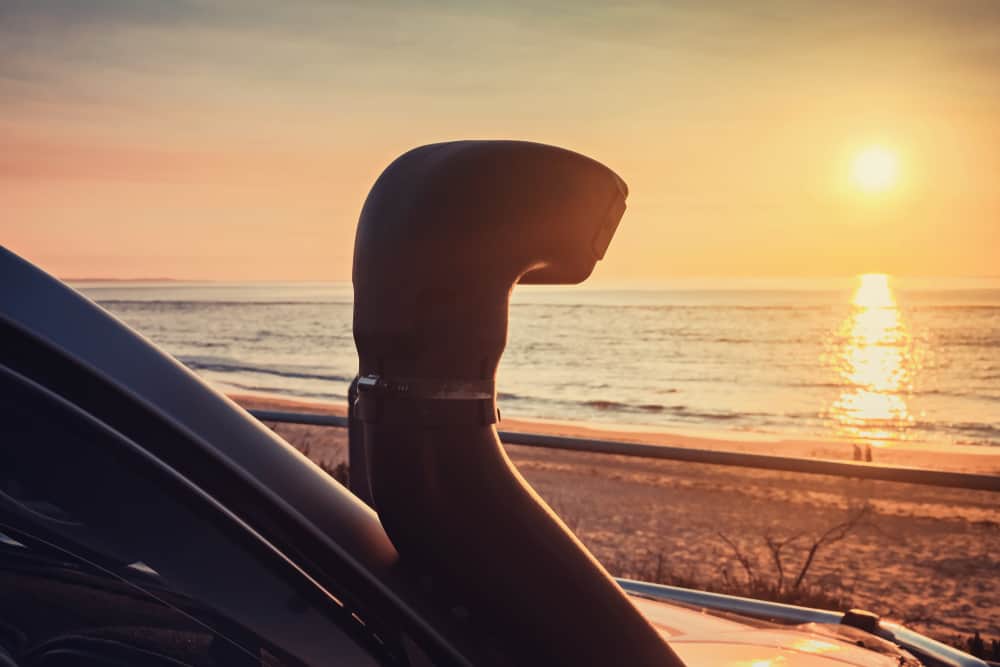
Have you ever seen big off-road cars with that weird tube on the side of their car going up? Well, that’s what they call a snorkel, but some people are afraid to put it on their off-roaders, thinking it will make their cars louder. So I did some digging to find out if a snorkel makes your car louder or not!
In most cases, it does increase the noise; you will hear your turbo spool (if you have one) and airflow from your air intake more audibly, but otherwise, it isn’t a massive difference. Mainly only the driver would pick up on it, as snorkels are found on their side.
People sometimes expect a massive sound difference from snorkels, when most of the time, it’s only a slight difference that mainly the driver picks up. Due to the snorkel being close to the window, people also pick up on more wind whistling at high speeds from the snorkel.
Is A Snorkel Loud?
Snorkels help increase the engine’s air intake flow and are positioned from the engine bay upward towards the driver’s side front window. Due to the positioning of the snorkel, drivers have pointed out that they hear more clearly the airflow through the air intake out of the engine bay. Cars with turbos are also mentioned to find that they hear the turbo more audibly.
It all comes down to your engine type; if you have a diesel engine, the noise might be more audible to the intense sound that one gets from a diesel-powered car that sounds like a truck while burning fuel at higher compression rates.
When fitted with a snorkel, air filters tend to act as noise inductors on their own, filtering the air intake while also humming the sound to reduce that feedback. On top of that, they are fitted with housings that reduce the sound as the air flows through the intake, similar to what a car’s exhaust does.
The other factor that can make a snorkel loud is nothing to do with what the snorkel is used for; in fact, it’s about where it’s allocated. When driving at higher speeds, people would realize a whirling wind-like noise. It is due to the wind not moving smoothly over the snorkel, almost like putting your head out of the window when you were little; it’s an obstruction to the wind.
However, there are different sizes and designs of snorkels on the market that could reduce this effect due to the wind at high speeds. But primarily, if your window is closed and well insulated, the noise wouldn’t be heard over the radio in the car.
How Does A Snorkel Work?
Snorkels are part of the air intake for the engine. Like all other engine cycles, the air is mixed with fuel to burn; the cleaner and more oxygenated the air, the better your machine performs. Snorkels are the main aftermarket parts off-roaders first apply to their cars to improve the performance of their vehicles and off-roading capabilities.
Snorkels increase airflow to the engine in 4×4 vehicles that go through high water levels; if a stock 4×4 were to go through high water, the front air intake would get filled with water which would stall the engine. The snorkel stops this from happening by placing the air intake above the engine bay and away from any moisture.
However, the performance of your snorkel will all come down to where your vehicle’s rated wading depth is. Wading depth is the level that manufacturers state to be a vehicle’s max depth. They can go inside a body of water, which accounts for electrical components that can be damaged by water exposure.
They are also used for really dusty trails or routes to reduce dust-filled air to get into the engine’s intake, which could cause complications. Most dusty air or unclean air lies close to the ground, so by having it above the vehicle’s roof, the engine can get a lot cleaner air to fuel the engine.
When replacing the original air intakes that used to be in the engine bay of a vehicle with a snorkel that’s now at the top near the windows, the air flows directly close by to your hearing, which can be heard unlike the stock air takes that were noise insulated by the engine bay. Which explains why some people question if it would be noisy?
Snorkel Heads
You get two main types of snorkel heads that help ventilate and filter dust particles or any water that gets into your snorkel. The two types are air ram heads, and the other is a vortex head that can be placed or replaced onto snorkels as you please.
As the name puts it, air ram heads are snorkel heads that ram air into the intake as the vehicle moves forward. The air rams head is designed as a scoop that forces any heavy particles of dust or water along the snorkel’s walls, then expels through vents. The filtered air then goes down the snorkel body towards the engine, free of any dust or water that could be harmful.
A vortex head works in conjunction with centrifugal forces to clean the air that moves around the head of the snorkel, similar to a tornado where it pushes up and outwards any particles like dust or water. The air swirls around where it then gets directed downwards into the body of the snorkel, clear of any harmful particles.
The head of this chamber gets narrower at the top, where particles get collected after being pushed outward in either a container or through vents. It all depends on the design of the head, whether it has a separate chamber or just slots for the dust to go through.
In harsh environments like heavy rain, snowfall, or sand storms, drivers with snorkels can twist their snorkel heads to face backward to reduce the number of particles inside the intake as they can get overwhelmed.

Is A Snorkel Worth It?
Snorkels are worth it when either going in deep pools of water to get across a lake or perhaps when driving behind a convoy of cars that are throwing a dust cloud at your vehicle. It will improve your vehicle’s overall performance and sometimes even its fuel efficiency.
Snorkels also reduce the cost of maintenance. The cleaner the airflow, the cleaner your air filters are, the less they need to be replaced. Also, your engine is exposed less to dirty air that could cause complications down the line that require significant repairs to your engine.
Conclusion
Snorkel heads are a positive add-on to an off-road vehicle, especially for those who know they want to go on extreme drives to see their car going in big pools of water or even dusty trails. One doesn’t have to worry about the noise increase when putting on a snorkel to make the decision easier.
However, some people do like the slight increase in the turbo, as it is found by some car enthusiasts beautiful to hear. Other than that, if you get easily irritated with small sounds like a faint whirring wind at high speeds from the snorkel, I wouldn’t prefer it.
References
- https://www.topgear.com.ph/features/tip-sheet/10-practical-tips-for-those-considering-installing-a-snorkel-on-their-vehicle-a36-20160628-lfrm
- https://www.arb.com.au/ask-arb-advantages-snorkel/
- https://www.timesnownews.com/auto/features/article/vehicle-snorkel-how-it-works-advantages-and-disadvantages-explained/639633

